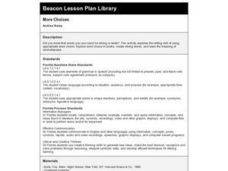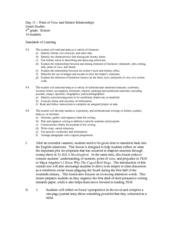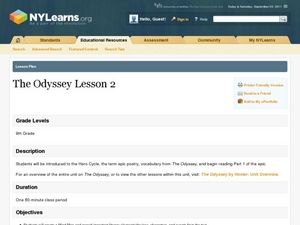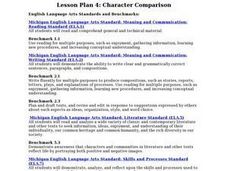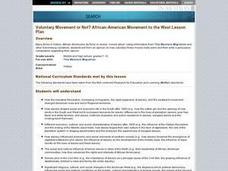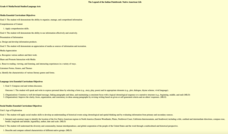Curated OER
More Choices
Fourth graders create onomatopoeia for a variety of things such as a mean dog, a crying baby or a doorbell ringing after exploring word choice as used by authors in selected books. They complete a Word Choice worksheet that is attached.
Curated OER
Amazing Adjectives
Fourth graders compose sentences that use descriptive adjectives to describe a specific food and day that they both like and dislike. They should really enjoy coming up with words that describe their favorite and least favorite foods!
Curated OER
The Name Jar
Students participate in a lesson that focuses on the literature of Korea. "The Name Jar" is read by students to practice some essential reading skills. This would include the recognition of sequence in a story, characterization, and...
Curated OER
Point of View and Mentor Relationships
Tenth graders analyze the role of mentors, point of view, and prejudice using the texts of To Kill a Mockingbird and Maya Angelou's I Know Why the Caged Bird Sings. For this literature analysis lesson, 10th graders review Scout's...
Curated OER
Wild Things
Students draw a literacy response picture demonstrating knowledge and appropriate use of computer hardware components (monitor, mouse) using KidPix and Kidspiration software with a minimum of two different pictorial details on their...
Curated OER
Contrasting Cinderellas
Students compare and contrast the traditional Cinderella to the modern-day fairy tale, Cinder Edna. In this fairy tales lesson, students read both stories and construct a Venn diagram to compare the two fairy tales. Students identify how...
Curated OER
Acting Like a Bunch of Animals: Fables and Human
The video "The Tales of Aesop" traces for viewers the history of fables and identifies their characteristics. The class then goes to the web site "The Fisherman and the Little Fish" where they examine the classic and a modern version of...
Curated OER
Stain My Days Blue
Students read several poems related to the life and culture of the Appalachia region. They are introduced to the poetic forms of simile, alliteration and onomatopoeia and respond to the poems through journal entries and poetry of their own.
Curated OER
The Classical Period
Sixth graders are introduced to the classical period in music history. After listening to examples, they identify and describe the characteristics of music during this time period and research the main composers. Using the internet,...
Curated OER
American Literature, The Earliest Days
Students prepare for and respond to literature selections. This package includes eleven lessons from the American Literature, The Earliest Days: Prehistory to 1750 each covering a different reading selection. Pre-reading and response...
Curated OER
The Necklace Of Teeth Comic Strip
Students create a comic strip which identifies the major events in a story of the teacher's choosing in this upper-elementary classroom language arts lesson plan. The lesson plan is highly adaptable and can be used in another content...
Curated OER
Early Explorer Time-Line
Fourth graders study exploration of the New World. In this Exploration Age lesson, 4th graders research early explorers and create time lines that include picture, captions, and the routes of the explorers studied.
Curated OER
The Odyssey Lesson 2
Ninth graders read and discuss part 1 of The Odyssey and create a mind map and visual images to represent vocabulary. In this reading lesson plan, 9th graders are introduced to poetry, and the Hero Cycle.
Curated OER
Commercials
Young scholars observe as the teacher demonstrates how to use a digital video camera. They experiment with the camera to get to know its features. Finally they create a video commercial and edit it, inserting sounds, titles and other...
Curated OER
Character Comparison: Tales of a Fourth Grade Nothing
Fourth graders compare and contrast Fudge and Peter, two main characters from "Tales of a Fourth Grade Nothing". They use a software template to analyze and compare the characters in a rough draft, edit their work and then produce a...
Curated OER
People, Not Numbers: Bringing 12 Million into Personal Ter
Young scholars forge a compassionate link to the large numbers of people who were the victims of slavery as opposed to thinking of them simply in terms of numbers. They perform a math exercise to put the number of people in slavery into...
Curated OER
Pictorial Portfolio
Students develop a pictorial portfolio of important assignments, projects and activities through their high school years. They use a camera and decide what makes a good photograph. Students organize their photographs into a portfolio...
Curated OER
Silent Spring
Students read background information about Rachel Carson found on the listed website links. They analyze and answer questions about her work and how it is linked to science then they research pesticide usage and alternative methods.
Curated OER
Creating a Landmark Calendar-An Enterprise for Your School
Students scrutinize the steps necessary to produce a school calendar featuring local architectural sites and landmarks.
Curated OER
Colors Crackle, Colors Roar
First graders engage in a reading of poems in colorful language. They become with the interrelation of using Spanish and English words interchangeably in a text. The lesson also builds multicultural appreciation for young students.
Curated OER
Voluntary Movement or Not? Africian-American Movement to the West
Ninth graders, in groups, determine reasons for African-American migration to the west
Curated OER
The Legend of the Indian Paintbrush: Native American Life
Pupils read," The Legend of the Indian Paintbrush" by Tomie dePaola and discuss the way legends are passed down orally. They then create their own legend and illustrate it on a simulated "Buffalo Skin" made from brown paper.
Texas Education Agency
Texas Gateway: Teaching Elements of Personal Narrative Texts
This resource presents instructional writing practices that support content-area learning, with specific strategies for teaching the thinking skills, processes, and knowledge needed to effectively write personal narrative texts. Some of...
ReadWriteThink
Read Write Think: Comics in the Classroom: Introduction to Narrative Structure
Contains plans for four lessons that teach students about narrative plot structures by using "The Three Little Pigs" fairy tale or a similar story. In addition to objectives and standards, this instructional plan contains links to sites...


